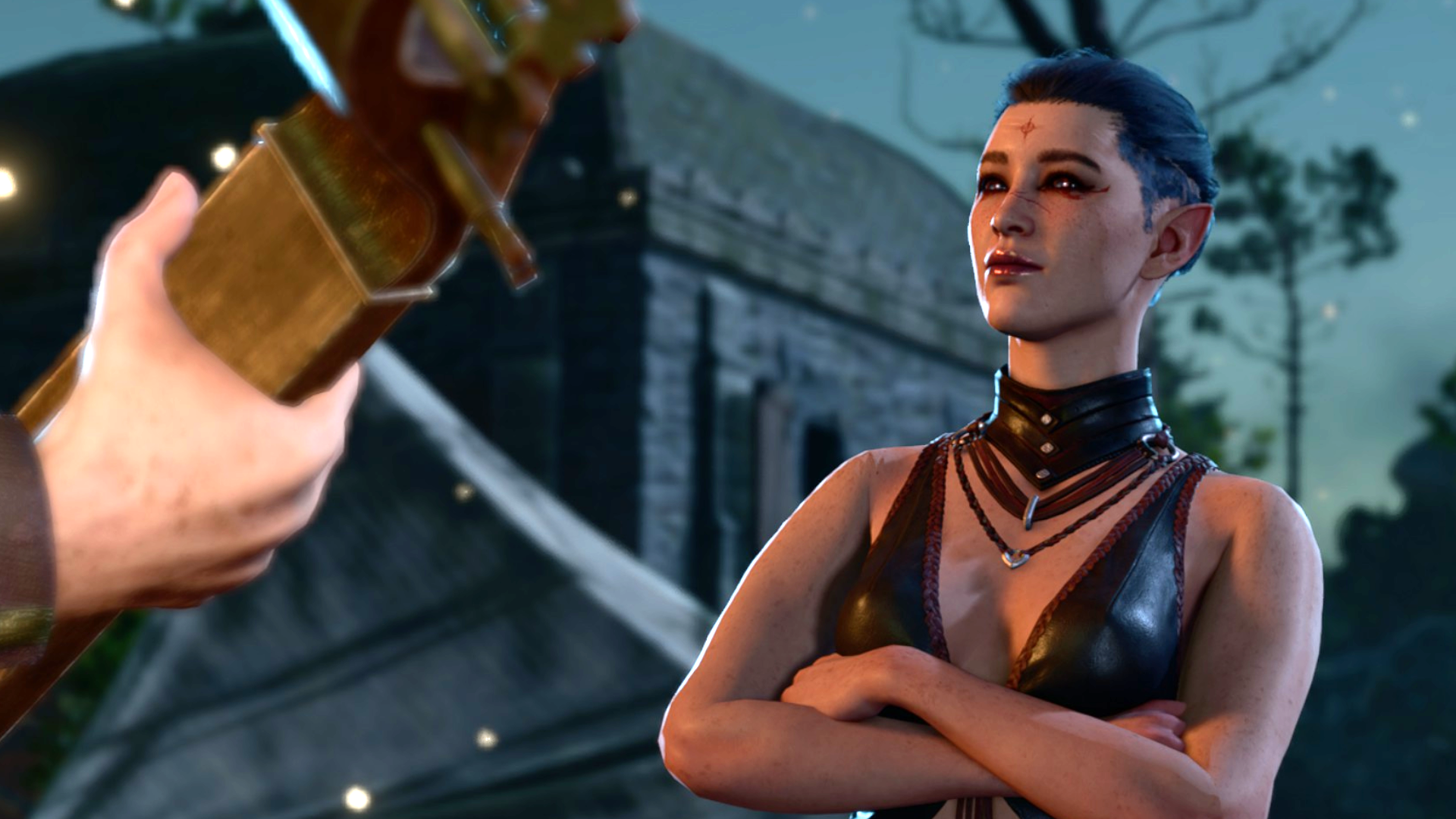The Bard has a reputation in Dungeons & Dragons at-large, let alone Baldur’s Gate 3. Stereotypes would tell you that it’s a class for silly little guys, only played by those with a penchant for seducing dragons and getting themselves into trouble. Sure, they’re not immune to becoming badasses—like one Scanlan Shorthalt from Critical Role—but they often do so in a subversive way. Underdog extraordinaires, rather than leading roles.
The dialogue options given to Bards in Baldur’s Gate 3 often play the same tune. Funny flirts, jibing comments, insinuations about a certain devil’s sexual performance. You’re meant to be the fast-talking scamp. However—due to some certain tweaks Larian made to the College of Swords Bard (and a few busted items), it’s, well, kind of a monster.
The stats-obsessed BG3builds subreddit would agree. Do a cursory search for “Swords Bard” and you’ll see what I mean. “Swords Bard is kinda crazy“, “Swords Bard is a better control caster than Lore Bard“—I happened to choose Swords Bard on my honour mode playthrough, and I’m pleased to report that not only do I have my golden dice, but the build-heads are completely correct: Bard is busted as hell.
Why Swords, though?
(Image credit: Larian Studios)
OK, here’s the deal—College of Swords is horrifying. I’m sure there’s some equally-scary Gloomstalker hybrid builds that have it built for raw DPS, but not by much—a College of Swords bard can go toe-to-toe with the toughest of Fighters. Here’s a late-game example of what I mean, wherein my Bard goes full Rambo and pumps out six 24-35 damage hand crossbow shots out in a single turn with nary an Action Surge in sight.
I’m still a full caster, by the way.
So what in Mystra’s name is happening here? Well, Larian’s made a super important change to the way the College of Sword Bard’s Slashing Flourish works when compared to its less deadly tabletop cousin. Here’s the text for Slashing Flourish in 5th edition Dungeons and Dragons:
“You can expend one use of your Bardic Inspiration to cause the weapon to deal extra damage to the target you hit and to any other creature of your choice that you can see within 5 feet of you. The damage equals the number you roll on the Bardic Inspiration die.” Also, you can only use one Blade Flourish per turn.
While an extra dice of damage to another enemy is neat, it’s nothing to write home to Volo about. However, in Baldur’s Gate 3, Slashing Flourish allows you to make two attacks (against any targets within the weapon’s range—even the same one) and adds your Bardic Inspiration die to both. This can also apply the Sharpshooter Feat (+10 to damage with a penalty to your attack roll), and has no restrictions on uses per turn.
Let’s go ahead and do some quick maths. Assuming both versions of this character have 18 Dexterity and the Sharpshooter feat, here’s how much damage a Bard deals at level 8 with a single use of Slashing Flourish, wielding a hand crossbow.
D&D 5e tabletop: 1d6 + 10 + 4 + 1d8 piercing, plus 1d8 piercing damage to a target within five feet of you, for a total of 17-36 damage.Baldur’s Gate 3: 1d6 + 10 + 4 + 1d8 piercing damage, twice, to any targets within range of your hand crossbow, for a total of 32-56 damage.
As mentioned, the tabletop version of the Swords Bard can also only Slashing Flourish once—Extra Attack lets its Baldur’s Gate 3 cousin do this twice, for a total of four attacks. As for why I get another two attacks in that video, that’s down to me having a crossbow in my offhand and a couple levels in rogue—giving me two bonus actions with which to pop somebody. If all six attacks hit, we’re talking 96-168 damage a turn minimum, not factoring in crits.
Granted, Bardic Inspiration is a finite resource. You’ll only ever have around five per Short Rest at higher levels—that’s 15 Slashing Flourish attacks a day (seven and a half turns of busted damage per Long Rest, two and a half per combat). But if you’re playing your cards right and stocking up, you should easily have over 1,000 camp supplies for most of an Honour Mode playthrough anyway, and very few story moments will punish you for taking them liberally.
The absurd thing here? I didn’t even freaking do it right. My Swords Bard felt super strong throughout my Honour Mode playthrough, and that was with me foolishly tossing a few key items aside.
Homebrew makes you hench
(Image credit: Larian Studios)
Larian’s buckwild homebrew items further push the Sword Bard’s potential as the ultimate master of Honour Mode—in particular, the Helmet of Arcane Acuity and the Band of the Mystic Scoundrel. I completely missed these items on my run and I still felt like a god.
First up, the Helmet of Arcane Acuity gives you two turns of the Arcane Acuity buff whenever you hit with a weapon attack, capping out at seven turns. Each turn remaining gives you a +1 to your Spell Save DC (the number an enemy needs to beat to resist one of your spells with a saving throw). With this thing equipped, a level 8 Bard with 20 charisma can get a spell save DC of around 23, and that’s without taking bonuses from other magic items into account.
Meanwhile, the Band of the Mystic Scoundrel lets you dedicate your action to attacking by giving you a bonus action cast of an Illusion spell (like Hypnotic Pattern) or Enchantment spell (like Hold Person) whenever you land an attack. You don’t have to know much about D&D to know that this is dumb and game-breaking. Oh, and you can grab some gloves in the Githyanki Creche in Act 2 that give you a flat 18 dexterity no matter what, letting you ramp up your charisma as high as you’d like.
So to sum it up—a College of Swords Bard deals damage that’s nearly on-par with a maxed out Fighter’s regular performance—while also letting them pop off powerful control spells on the same turn with near-certain effectiveness. But the real icing on the cake, here—the thing that makes this class the king of Honour Mode? You’re still playing a Bard.
You’ve only got one roll, do not miss your chance to blow
(Image credit: Larian Studios)
Honour Mode is a single-save-file only challenge. If you mess up an important social roll, you need to live with your consequences. The Bard is excellent at these, able to gain Expertise in those all-important social skills—while also equipped with spells to up their odds.
This is especially prevalent in Act 2, where several run-threatening fights can be cut short with a few hefty charisma checks—still giving you experience points for avoiding them, of course. The Enhance Ability spell is also a great boon, since you can cast it reactively—plus, even if you’re given something outside of your wheelhouse, you gain half your proficiency bonus to your non-learned checks anyway.
Yes, a Paladin or a well-optimised Gloomstalker Ranger/Rogue/Fighter multiclass will carry you through combat nicely. But neither holds a candle to the raw, skill-check beating charisma of a Bard, especially when you get those gloves I mentioned and ditch all your dex to go whole-hog on social graces.
Honestly, if you’re embarking on an Honour Mode journey (especially now there’s even more Legendary Actions to contend with in Patch 6) I struggle to think of a better swiss army knife than the Swords Bard. Massive damage, the spell slots of a full caster, powerful control spells released with a measly bonus action, and a silver tongue that can slay your enemies with a well-reasoned argument. And if that fails? Well, why seduce a dragon when you can obliterate one with six crossbow bolts between the eyes?











